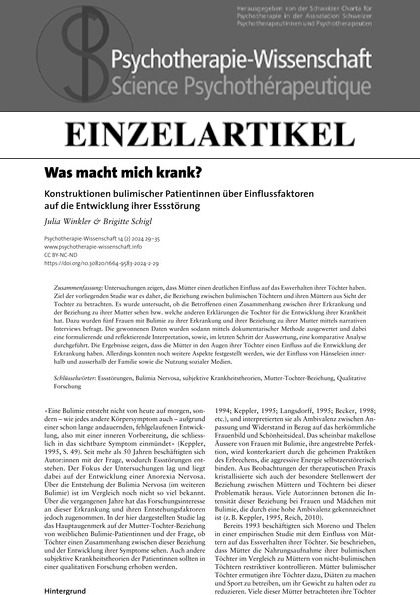What makes me ill?
Constructions of bulimic patients about factors influencing the development of their eating disorder
DOI:
https://doi.org/10.30820/1664-9583-2024-2-29Keywords:
eating disorders, bulimia nervosa, mother-daughter relationship, subjective theory of disease, qualitative researchAbstract
Research shows that mothers have a significant influence on their daughters’ eating behavior. The aim of the present study was therefore to look at the relationship between bulimic daughters and their mothers, from the daughter’s point of view. It was investigated whether the affected women see a connection between their mothers or what other explanations the daughter has for the development of her illness. For this purpose, five women with bulimia were interviewed about their illness and their relationship with their mother by means of narrative interviews. The data obtained were then analyzed using documentary methods, with formulative and reflective interpretation and in a final step of evaluation, a comparative analysis. The results show that mothers have an influence on the development of the disease in the eyes of their daughters. However, other aspects could be identified, such as the influence of teasing within and outside the family as well as the use of social media.
Downloads
Published
2024-10-18
How to Cite
Winkler, J., & Schigl, B. (2024). What makes me ill? Constructions of bulimic patients about factors influencing the development of their eating disorder. Psychotherapie-Wissenschaft, 14(2), 29–35. https://doi.org/10.30820/1664-9583-2024-2-29
Issue
Section
Original Work
License
Copyright (c) 2024 Julia Winkler, Brigitte Schigl

This work is licensed under a Creative Commons Attribution-NonCommercial-NoDerivatives 3.0 Unported License.
This journal provides open access to its content in accordance with the basic premise that the free public availability of research benefits the exchange of knowledge throughout the world.
Authors wishing to publish in this journal agree to the following:
- The author/s retain/s the copyrights and consent/s to initial publication of the work in the journal under a Creative Commons Attribution licence, which allows third parties to use the work by citing the name/s of the author/s and this journal as initial publisher (in accordance with the Creative Commons Attribution-NonCommercial-NoDerivs 3.0 DE-Licence).
- The author/s can enter into additional contracts for the non-exclusive distribution (e.g. publish in a collection or book) of the version published in the journal, if the journal is cited as initial publisher.


